Succession planning is the process of identifying and preparing internal staff with the potential of leadership to fill key leadership positions within the organization. Researchers have established that HR analytics play strategic role in succession planning and promotion in organizations.

Organizations should follow a proper structured approach or system for discovering and promoting the most qualified candidates. Organization’s success mainly depends upon the caliber of its workforce that ultimately determines the survival and growth of the organization and is the main source of building competitive advantage over other organizations.
Organizations have generated statistical models to predict turnover, helping managers to quickly alter work conditions to prevent top performers‟ from leaving.
| Contents |
| Data Analytics and Metrics for Succession Planning |
| Steps For Succession Planning |
| Assess |
| Evaluate |
| Develop |
| Conclusion |
Data Analytics and Metrics for Succession Planning
Data analytics practice can look at all the possible combinations of job role, skill, position, geographical location and point out portions of the organization with the highest employee tenure, and help figure out where to focus training and recruiting expense.
Data related to projects experience, designations, performance appraisals, previous career roles and others can all be used in order to derive insights about possible successors for a leaving employee.
A good successor recommendation system should be able to find employees who are the closest possible fit for a leaving employee while also ensuring that the successor can be a strong and productive contributor in his new role.
As such, it is necessary to design two distinct metrics:
Similarity Metrics
These types of metrics evaluate how closely the available employee pool matches an outgoing employee. E.g., organizations can evaluate how closely a successor’s designation, skill set, training profile, or experience matches with the outgoing employee.
Evaluation Metrics
These types of metrics evaluate employees to ensure they can be a strong contributor to the organization in their new role. E.g., potential successors can be ranked on the basis of their performance appraisal scores, awards won, conferences attended, the size of the team they have worked with etc.
Steps For Succession Planning
Let us know go through the steps of successful planning process of succession planning. A robust succession planning process provides a roadmap for success; Ensuring the necessary structure to support effective, efficient, and consistent communication and implementation throughout all levels of the organization. There are three broad steps.
Assess
Identify significant business challenges in the next 1-5 years
A business unit’s or departments strategic plan can serve as the starting point to identify the current and future challenges. Review of each business function and strategic area focusing on what new capabilities will be needed to deliver the required strategy plan will be very critical. The review should proceed as follows:
- Compare the long-term strategic plan to the current organization chart to determine whether the current framework aligns with the organization’s long-term goals.
- Does the current organizational structure and job definitions work together to achieve all the goals of the strategic plan?
- If no, schedule planning sessions to identify gaps in current positions and organizational structure that needs to be filled to reach long-term objectives.
- Work towards to design future job descriptions to create a pool of leaders, the managerial skills and duties which would be critical.
- Guidance for expected skills of both employees and managers needs to be clear and differentiated at all job levels. Knowing the intermediate- and advanced-skill levels that must be achieved by employees facilitates transparent opportunities for advancement for all employees.
- Remove the guesswork about the expectations for obtaining a higher position.
- Ensure that professional advancements pathways are reviewed and revised in the future.
A strategic business plan would primarily constitute Business concept (Business overview, Value proposition, Services offered, Revenue streams), Market Analysis (Target Customers, Market characteristics and trend, Market size and Revenue potential, Business Models), Competition, Company Objectives and Strategies (Business objectives, Business Strategies, Competitive advantages). If for any reason, the department or business unit doesn’t have a strategic plan or it is not drilled down enough to team’s specific strategies and priorities, an environmental scan can provide with enough information to start the succession planning process.
Environmental scans can be conducted during a brainstorming session at a team meeting through surveying or talking with stakeholders, or by a combination of these methods. As an example, let us take a look at a simple management consulting firm with a strong technology arm and see how a template can help gather the information.

Identify pivotal positions and/or incumbents
A sudden vacancy in a critical operational role cannot only leave an organization scrambling to fill in, but it may also leave a significant gap in knowledge and experience that takes time to rebuild. The positions can become vacant on account of multiple reasons such as retirements, turnovers or any unforeseen circumstances like death of employees etc.
Essentially, we need to first identify which roles have the greatest impact on company’s performance and would also be the most difficult to replace. We may choose to designate a position as pivotal because of the importance of the duties and responsibilities or because of the incumbent’s specialized KSAs.

Definition Vacancy Risk- This is the amount of time pending until the position becomes vacant. • High - 1 to 180 days • Medium – 180 days to 3 years • Low - Greater than 3 years Position Impact- This is the effect that a vacancy will have on the role of position. The full and actual impact to the organization should be clearly identified in the assessment. • High - Immediate impact on the organization’s ability to uphold the responsibilities of the position. • Medium - Slight impact felt immediately. Position must be filled ASAP. • Low – Potential to create an inconvenience, but organization maintains responsibilities. Total Attrition Factor - Estimated effort and urgency to the delivery of programs and services. Position Impact factor * Vacancy Risk factor = Total Attrition factor • High – 6 and higher • Medium – 4 -6 points • Low – 1-3 points
If we decide not to designate a position as pivotal, it doesn’t mean we could or should eliminate that position. It simply means turnover in the position would not be overly disruptive to our area. Selecting the right positions to focus on is important to the successful outcome of the plan.
So to decide which roles are critical, a Critical Role Identification Questionnaire can be used. The questionnaire suggests four relevant criteria to use in evaluating which positions are critical.
- Impact to business operations: What will be the impact on day-to-day operations or business revenue if this role was suddenly vacant?
- Availability of external candidates: How difficult it would be to find qualified external hires to replace the said position?
- Internal bench strength: Are there qualified internal candidates who could step into this role today?
- Unique skill-set or knowledge base: Does this role require skills or knowledge that would be difficult to replace, or demand specific experience?
A full exhaustive approach will help in the evaluation process to reduce the list to few most critical roles. The management team should discuss each of the criteria for all the shortlisted roles to pare the list down to the top role or roles to focus on initially.
Identify knowledge, skills and competencies that are critical success factors
After determining which positions are mission critical and have a significant vacancy risk, identification of competencies, skills and institutional knowledge which are critical success factors for each of the positions becomes important. Using this information as an aid we can identifying and develop potential replacements for a pending vacancy.
An opportune time to identify and refine the core competencies associated with an organization’s high priority positions is during annual job description review. During this annual review, human resources and supervisors can intentionally define and incorporate core competencies (or review core competencies that already exist) into the job descriptions of critical positions.

Competency framework helps to identify the factors and behavior’s which contribute to the success inside of a role that will soon be left empty. A simple form as below can help capture the competencies and other relevant details.

Evaluate
Identify high potential employees
When selecting potential candidates for current or future needs, considering incumbents in declining or less essential functions and/or those with high potential who are not challenged in their current position is a good option. Retention and internal promotion preserve institutional knowledge and minimize disruption to operations. To identify right candidates we need to:
Assess potential
To help identify high potential employees, we need to ask few questions like
- Does the person take charge and make things happen or sit back and let things happen before producing?
- Do obstacles stop the person? Or do they represent challenges, not threats?
- Does the person inspire confidence in his or her decision making?
- Can the person lead through persuasion and influence? Can he or she serve as an effective sounding board to others who are struggling with complex issues?
- Do others trust the person to lead projects and teams, even though he or she doesn’t have a leadership title?
- Can the person keep a high-level perspective? Are priorities apparent, or does she or he becomes mired in the details and tactics?
Assess current performance
Assessing performance would mean a constant observation of employees and their work, reviewing performance evaluations, and /or conduct a 360 degree feedback.
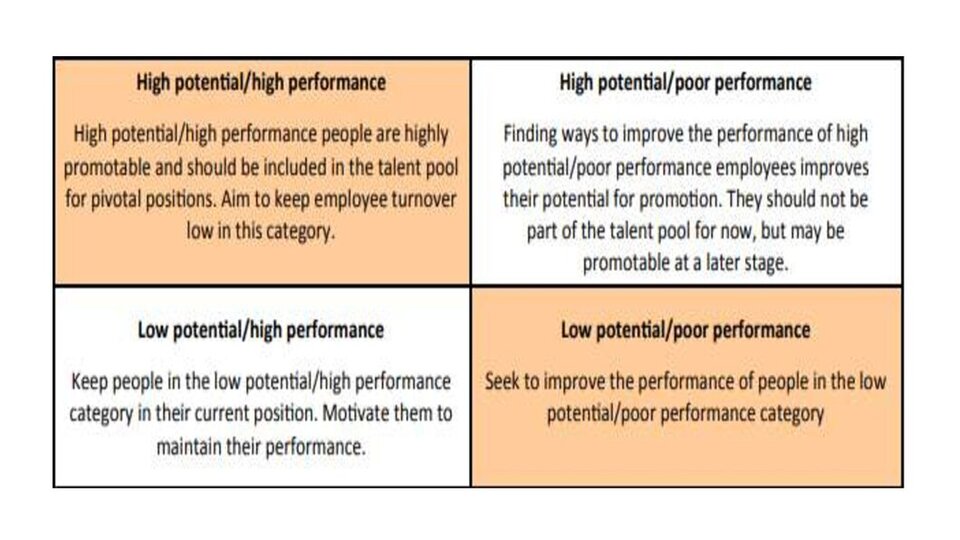
Motivation – Are potential candidates interested in advancing their careers? Are they committed to learning new skills? If employee aspirations do not match organizational goals, consider other candidates. Ask yourself how you will nurture the leaders of the future without alienating fellow workers who may not meet the requirements for the top job. Is there an opportunity to develop multiple employees?
To capture all the details, a below form would help gather information.
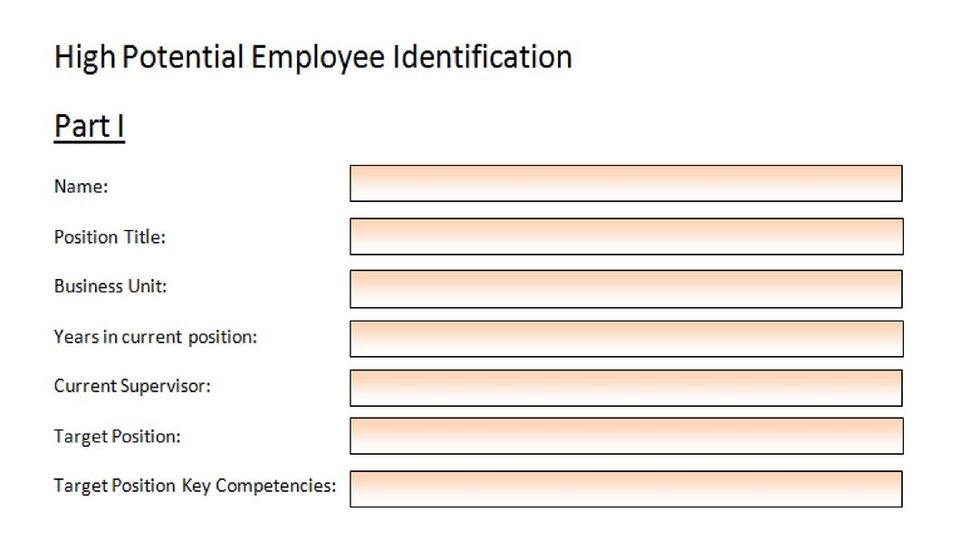
Rate the leader
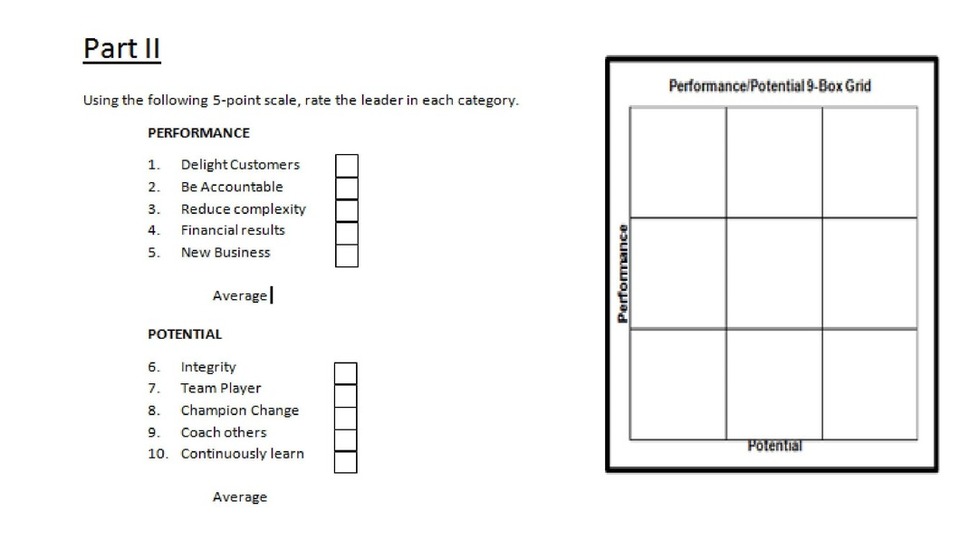


Select the competencies individuals will need to be successful in positions and to meet identified business challenges
Preparing an individual to progress in the organization often takes a combination of formal training, thoughtful coaching, trusted mentorship, and key assignments. Managers and executive leadership play a key role in creating access/removing barriers to key assignments and providing honest feedback along the way.
Managers should be having ongoing career development conversations with all employees in addition to their annual performance reviews. Career development conversations with high potential employees should be focused on closing the gaps and/or strengthen existing skills and competencies.
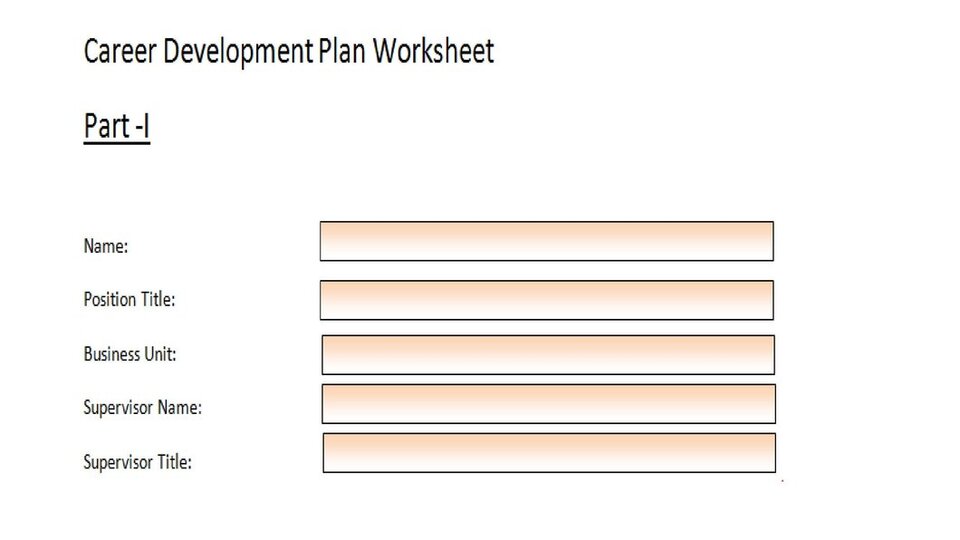
Using a career development plan worksheet as a tool can help you organize your thoughts and chart your progress over a specified time frame.. Completion of plan will address specific career related questions and would involve specific details.



Categorize skill or competency gap
To begin identifying the competencies and skills that are lacking, companies should undertake a structured self-assessment. Conducting multi-perspective assessment several times, independently by different functions – for instance, by top management, HR, and operations would help identify common pain points. The gaps can be identified majorly under two categories.
Managerial competencies
Managing change, Planning and Organization, Interpersonal skills, Result orientation and Leadership
Technical competencies
Technical competencies would vary as per the position and role identified for the purpose of succession planning.
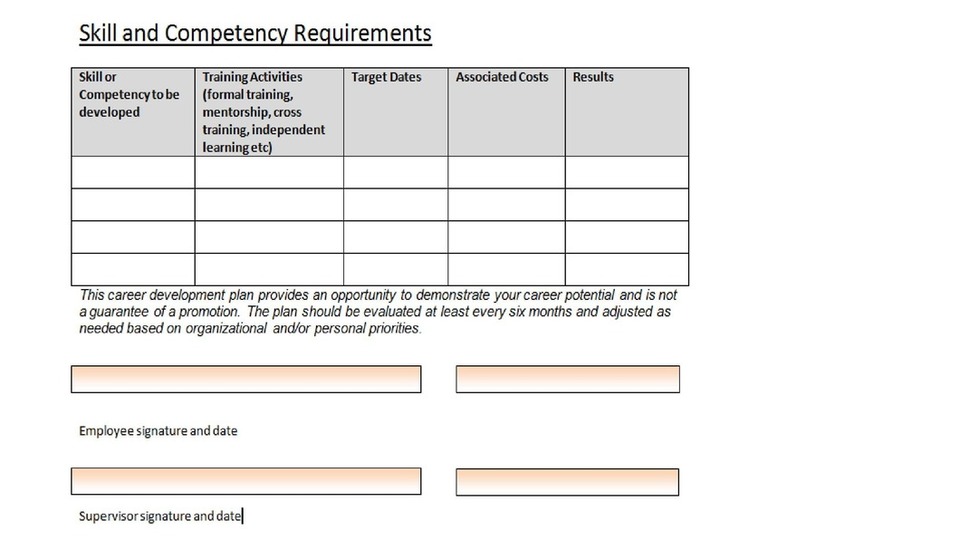
Once the competencies or skills gaps have been identified and quantified, the next step is to prioritize the skills gaps to ensure that the most pressing ones are addressed first.
Develop
Capture the knowledge that individuals possess before departing the organization
One of the greatest challenges facing employers is how to retain all of that expertise when employees leave. The fact is employees take with them a substantial amount of work, business customers/clients, and operational knowledge that can be difficult to replace or duplicate. Let us look at the three primary ways of retaining organizational knowledge when employee decides to move on.
Document processes and procedures
From the very beginning, an employee should have a clear and concise job description that is familiar to both their manager and human resources. The job description and corporate procedures should make clear the role and responsibilities associated with the position, and those responsibilities should be understood among all parties.
A matrix of responsibilities can successfully encompass all of the varying degrees to which a person must perform their specific job. Writing training manuals is one way employees can list their individual job-related responsibilities. This will help both the potential successor and the rest of the team in understanding the role and overall duties.
Cross-train team members
Ensuring that members of the team can step into another role at any given time is critical to preventing gaps in knowledge. When implementing a cross-training period, it’s important to provide plenty of time for people to train effectively.
It’s during this time that everyone on the team will be learning their team member’s roles and overall picture and be able to step in and properly perform the job. One of the most effective ways to accomplish this task is to have people shadow each other.
This ensures the person accepting the knowledge is just as knowledgeable as the one passing it on. The best way to hold people accountable is to test them while a key team member is away.
Create a mentor program
Mentoring is an effective way to organize, create, capture, and distribute knowledge. This mutually beneficial relationship provides a baseline of knowledge for the company/mentor while simultaneously fueling succession planning for the mentee.
As we know ways of retaining knowledge, let us quickly also look at what information needs to be included (the list is an indicator and it can be modified as per the requirements of organization)

Develop a pool of talent to step into critical positions through targeted career development strategies
Many components of succession planning can and should be made more scientific to reap the greatest benefit for the organization. Successful career development practice is designed to give an organization competitive advantage in attracting, retaining and developing best people.
A strategy for career development needs to embrace changing ideas about what a career consists of as well as changed assumptions about development.
Earlier organizations used appointment processes, such as assessment centers, promotion boards, interviews and assessment using psychological tests to manage the careers of wider workforce. Since the pendulum has shifted from organizations to individuals, new activities such as career workshops, personal development plans, learning centers and self-help books and open-learning materials are critical.
In general, there are five –phase, High Performance Career Development framework which can be use for career development.
Develop complete career development framework
Create a career framework that starts with a specific job role identify job family, career level, and career stream. The process of building the framework is different for every organization. The key is to take a wide lens and understand both organizational and employee goals for having a career development structure and career paths.
It is then critical to involve a wide variety of stakeholders and make sure the framework aligns with the culture and there is governance in place to guide the process.
Implement career development with technology
Career development is complex and involves a collection of conditions, strategies, and processes that must work in harmony. Companies utilizing career and competency technology have a distinct advantage. Technology is readily available, both as part of a suite of talent solutions or as a point solution.
Develop career paths aligned with competencies
For career paths to resonate with employees and provide value to the employer, they must be linked to an employee’s performance. Aligning competencies with career paths provides a clear roadmap for employees. They can see skills they must master through experience, training, or both. Whether universities or associations must provide external learning and whether certifications are required internal or external can be understood by the employees.
They can understand how long they are expected to stay in a role and the expected level of performance before they advance. Having competencies in place and aligning them to career paths is extremely important which requires wide collaboration among stakeholders and can be expensive. Research has shown a strong correlation between career path-competency alignment and improved business metrics.
Flexibility to change career streams or levels based on changing personal or professional priorities
Organizations that design ways for employees to change direction—horizontally, vertically, or into an entirely different career stream or level—have a competitive advantage over other organizations. When designing career frameworks, it is important to avoid focusing only on the present and consider how the workforce might look in the future.
Businesses that designed ways employees can move into career streams or career levels based on changing personal and professional priorities are still in the minority. Developing this level of flexibility is not easy and requires resources, but there is a correlation between this flexibility and key business metrics, particularly when it comes to employee engagement.
Staying invested in career coaching
Coaching has a strong positive impact in many areas: learning, performance management, leadership development, and even wellness and well-being. It is not surprising that career coaching has an impact on career development, as well.
Career coaching can be done formally through specially trained career counsellors (either internal or external), career development portals, and targeted career development meetings or informally through in-the-moment and ongoing feedback. A significant cultural emphasis on career development is reflected in career coaching, especially in organizations that provide both formal and informal support.
Take your Succession plan to New Heights
There’s no doubt about it, building a scalable and dependable leadership pipeline is difficult. But organizations that invest in succession planning are primed for competitive advantage, and will be more prepared for turbulence in a rapidly changing economy. Proper succession planning instils confidence across the organization that selection of future leaders is strategic, comprehensive, and fair.
While development plans and succession charts aren’t promises, they are often communicated as such and can lead to frustration if they aren’t realistic. Bottom line; don’t jerk around high performing leaders with unrealistic development expectations. Only give the promise of succession if there is a realistic chance of its happening!


